Abstract
Objective
Updated cochlear implant technology and optimized fitting can have a substantial impact on speech perception. The effects of upgrades in processor technology and aided thresholds on word recognition at soft input levels and sentence recognition in noise were examined. We hypothesized that updated speech processors and lower aided thresholds would allow improved recognition of soft speech without compromising performance in noise.
Study Design
109 teenagers who had used a Nucleus 22-cochlear implant since preschool were tested with their current speech processor(s) (101 unilateral and 8 bilateral): 13 used the Spectra, 22 the ESPrit 22, 61 the ESPrit 3G, and 13 the Freedom.
Main Outcome Measures
The Lexical Neighborhood Test (LNT) was administered at 70 and 50 dB SPL and the Bamford Kowal Bench sentences were administered in quiet and in noise. Aided thresholds were obtained for frequency-modulated tones from 250 to 4,000 Hz. Results were analyzed using repeated measures analysis of variance.
Results
Aided thresholds for the Freedom/3G group were significantly lower (better) than the Spectra/Sprint group. LNT scores at 50 dB were significantly higher for the Freedom/3G group. No significant differences between the 2 groups were found for the LNT at 70 or sentences in quiet or noise.
Conclusion
Adolescents using updated processors that allowed for aided detection thresholds of 30 dB HL or better performed the best at soft levels. The BKB in noise results suggest that greater access to soft speech does not compromise listening in noise.
Keywords: Adolescents, Cochlear implant use, Long-term, Speech perception
Updated cochlear implant technology, in combination with optimized fitting parameters of the cochlear implant by the audiologist, can have a substantial impact on speech perception outcomes for cochlear implant users. The goal of the cochlear implant fitting is to adjust the processor and use fitting parameters that provide audibility and comfort for a variety of input levels from soft to loud in a variety of listening environments without compromising the user's ability to recognize speech in a noisy background.
Effects of Technology Upgrades on Speech Perception
The speech perception abilities of pediatric cochlear implant recipients have shown steady improvements because cochlear implants became commercially available for children in the early 1980s. Technological improvements in speech coding strategies and speech processor design have made substantial impacts on speech perception abilities of both adults and children. For example, the introduction of speech coding strategies, such as spectral peak (SPEAK) and continuous interleaved stimulation (CIS) produced large improvements in perception of both consonants and vowels compared with earlier processing strategies (1,2). A nationwide sample of children, many of whom initially used the M-PEAK strategy and upgraded to the SPEAK strategy, exhibited higher speech perception scores the longer they had used the SPEAK strategy (3). Furthermore, the benefits to children's speech perception of SPEAK over M-PEAK were more apparent for noisy than quiet listening situations (4). In addition to improving speech perception in noise, newer technology has been associated with improved access to soft speech. Audibility of soft speech is especially important for young children, who learn language through both active and passive exposure in a variety of auditory environments throughout the day (5,6). Skinner et al. (7) found that subjects using earlier generation speech processors (wearable speech processor [WSP] and mini speech processor [MSP]) had average aided thresholds that ranged from 35 to 50 dB HL at frequencies ranging from 250 to 4000 Hz. Whereas thresholds in this range would allow for detection of most conversational levels of speech (~40–44 dB HL), speech presented at soft levels (~30–34 dB HL) would remain mostly inaudible. These thresholds are in contrast to average thresholds that ranged from 25 to 30 dB HL for a group of subjects that were tested with newer processors, specifically the ESPrit 3G and SPrint (8). These subjects were able to detect and perceive soft speech levels (9). Cochlear implant fittings that ensure aided thresholds in the 20 to 35 dB HL range provide the best opportunity to hear the acoustic cues of soft speech (8,10–13).
Developments in speech processors, such as automatic gain controls, preprocessing strategies and increased input dynamic range (IDR), have resulted in greater access and comfort for a variety of speech levels from soft to loud. Input syllabic compression implemented in the microphone circuitry of the Spectra and the SPrint improved perception of soft speech levels for adults (14). Later generation processors, the ESPrit 3G and the Freedom, used the Whisper setting, a form of automatic gain control that allows for detection of softer input levels of speech. Preprocessing strategies, such as Adaptive Dynamic Range Optimization (ADRO), also have been implemented on later generation Nucleus processors. The ADRO processing scheme is designed to place the incoming speech signal into the optimal range of the cochlear implant user's electrical dynamic range (i.e., from threshold to comfort levels for electrical stimulation) by continuously adjusting the gain of the input signal. Studies on adults revealed improved sentence and word recognition for soft level speech (i.e., 40–50 dB SPL) using the ADRO strategy (12). Similarly, Dawson et al. (15) found improved word recognition in quiet and sentence recognition in noise for 15 children ranging in age from 6 to 15 years using the ADRO strategy. The IDR, the range of acoustic signals that are mapped on to the cochlear implant user's electrical dynamic range, has been shown to have an impact on speech perception of children and adults. Specifically, a wider IDR improves the perception of speech, especially soft speech levels (2,11,16–18). Improvements in consonant and vowel recognition, as well as improvements in overall word and sentence recognition at soft levels, have been documented. A recent study of 30 children (age range, 7–17 yr) using the Nucleus Freedom processor found that increasing the IDR from 30 to 40 dB resulted in significantly improved aided thresholds and word recognition scores at 50 dB SPL without compromising comfort of higher level speech inputs or sentence recognition in noise (19).
Effects of Fitting Procedures on Speech Perception
The programming of the cochlear implant by the audiologist has been shown to make an important contribution to successful outcomes with cochlear implants. The fitting parameters of the cochlear implant must be optimized so that a highly audible and comfortable speech signal is provided to the individual wearing the device. Audiologists must adjust the electrical threshold levels (T levels) and maximum comfort levels (C levels) across the electrodes so that the speech signal is delivered to the individual electric dynamic range for optimal audibility, comfort, and loudness growth. Studies by Skinner et al. (8,13) demonstrated the use of using cochlear implant mapping procedures, loudness scaling judgments, and sound-field thresholds for fitting adults with cochlear implant systems. These procedures ensured that the acoustic cues of speech, occurring over a wide range of frequencies (i.e., 250–8000 Hz) and intensities (50–80 dB SPL), were audible and comfortable. A study by Geers et al. (3) revealed that cochlear implant maps characterized by maximum number of active electrodes, wide electrical dynamic range (range between the threshold T level and maximum comfort level C Level), and optimal growth of loudness contributed substantially to the child's ability to hear speech.
Purpose of the Current Study
In the following study, we examined the effects of upgrades in processor technology and aided thresholds on word recognition at soft input levels (50 dB SPL) and sentence recognition in noise. We hypothesized that adolescents who used more recent generations of speech processors and those with the lowest aided thresholds would have better recognition of speech at soft levels without compromising their performance in noise.
METHODS
Participants
Approximately 112 teenagers who were implanted during their preschool years participated. The teenagers received 1 cochlear implant between 1990 and 1996 when they were between 1.8 and 5.4 years of age. Each had participated in a previous research study at some point between 1996 and 2000 when they were between 8.0 and 9.11 years of age (3). Data collection for the current project took place between 2004 and 2008 when the students ranged in age from 15.5 to 18.5 years. Average duration of cochlear implant use for the group was 13 years 3 months. Students reported high satisfaction with their cochlear implant. Eighty percent reported wearing their CI all of the time and 20% some of the time. No one reported being a nonuser. Ninety-one percent reported they would have difficulty understanding the speech of others if not wearing their implant, and 96% relied heavily enough on their CI that, if broke, they would want to replace it.
Most of the teenagers were still using the Nucleus 22-cochlear implant system that they had received in preschool but had updated their speech processor. The processors used are listed from oldest to newest generation of commercially available speech processors. Some still used the Spectra (n = 13), whereas the others had upgraded to SPrint (n = 1), ESPrit 22 (n = 22), ESPrit 3G (n = 61), or Freedom (n = 13). One student used the Advanced Bionics Platinum processor, whereas the other had upgraded to the Platinum BTE. None used a hearing aid in the other ear. Eight of the students used bilateral CIs and were tested in the bilateral condition: 1 student used bilateral ESPrit 3Gs, 5 students used an ESPrit 3G and Freedom processor, and 2 students used bilateral Freedom processors.
Teenagers were tested individually using digitized presentation of recorded stimuli through a laptop computer to a loud-speaker approximately 3 ft away. The Lexical Neighborhood Test (LNT) word test (20) and the Bamford-Kowal Bench (BKB) sentences (21) were administered at a calibrated level of 70 dB SPL in the sound field. The battery also included testing in degraded listening conditions: LNT at a soft level (50 dB SPL) and BKB in 4-talker noise (+10dB signal-to-noise ratio). Aided thresholds for frequency modulated (FM)-tones in dB HL were obtained in the sound field at octave frequencies from 250 to 4,000 Hz with the cochlear implant.
Data Analysis
Speech perception scores at 70 versus 50 dB SPL and sentences recognition scores in quiet and noise were analyzed using a repeated-measures analysis of variance (ANOVA). Aided thresholds and speech perception scores for the different Nucleus processor types were compared using ANOVA. These analyses are based on 109 of the 112 subjects. To assess the possible effects of bilateral device use on device group differences, the 8 bilateral CI users in the Freedom/3G group were compared with the unilateral Freedom /3G CI users (n = 66), and device group comparisons were made with and without the bilateral CI students. The 2 children with the Advanced Bionics devices were not included because direct comparisons in processor upgrades are not possible, and because there was only 1 Sprint user, this child was excluded as well.
RESULTS
Figure 1 shows the group mean FM-tone, sound-field threshold levels at 250 to 4,000 Hz for children wearing newer processors (Freedom and 3G) and those wearing the earlier generation processors (Spectra and ESPrit 22). Results from the ANOVA revealed that the thresholds for the Freedom/3G group are significantly lower (better) than the Spectra/ESPrit 22 group at all frequencies (250–4,000 Hz) (250 Hz [F1,107 = 22.97. p < 0.001], 500 Hz [F1,107 = 24.29, p < 0.001], 1,000 Hz [F1,107 = 14.55 p = 0.002], 2,000 Hz [F1,107 = 20.87, p < 0.001], and 4,000 Hz [F1,107 = 14.89, p = 0.002]). There were no significant differences between the unilateral and bilateral CI users in the Freedom/3G group for aided thresholds across any frequencies. Differences between the processor groups remained significant at the p < 0.0001 level when the 8 bilateral CI users were excluded from the Freedom/3G group. Results from the ANOVA revealed no significant differences between speech processors within each group (Freedom versus 3G or Spectra versus ESPrit 22).
FIG. 1.
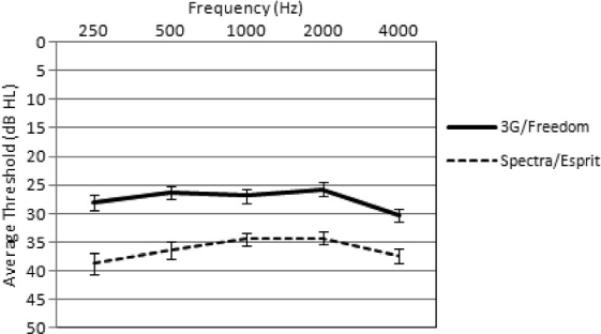
Mean aided FM thresholds (n = 109) from 250 to 4,000 Hz for the Freedom/3G group (solid line) and the Spectra/ESPrit 22 group (dashed line). Error bars represent ±1 standard error of the mean.
Figure 2 shows the group mean FM-tone, sound field threshold levels for the 2 processor groups plotted on Mueller & Killion's (1990) count-the-dot matrix for the calculation of the articulation index (AI). The AI was 0.74 for the Freedom/3G group and 0.45 for the Spectra/ESPrit 22 group.
FIG. 2.
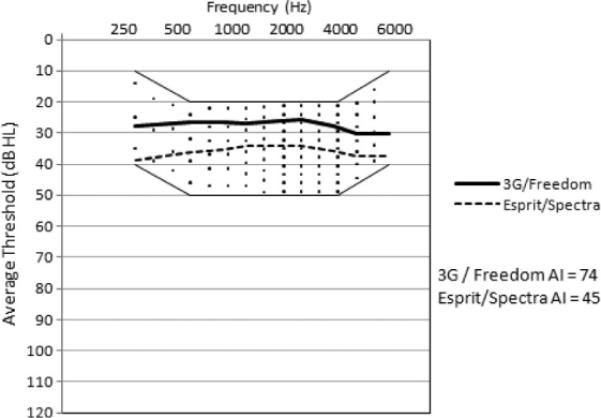
Mean aided thresholds for the Freedom/3G and the Spectra/ESPrit 22 groups plotted on the Killion and Mueller count the dot audiogram. Calculated AI shown for each group.
Figure 3 shows the group mean LNT scores were 60% and 47% correct for 70 and 50 dB SPL, respectively. The scores for the BKB sentences in quiet and in noise were 80% and 52%, respectively, and are shown in Figure 4. Results from the repeated-measures ANOVA revealed that the difference in level (70 versus 50 dB) (F1,111 = 62.28, p < 0.0001) and the difference in quiet versus noise (F1,111 = 287.5, p < 0.0001) were both significant.
FIG. 3.
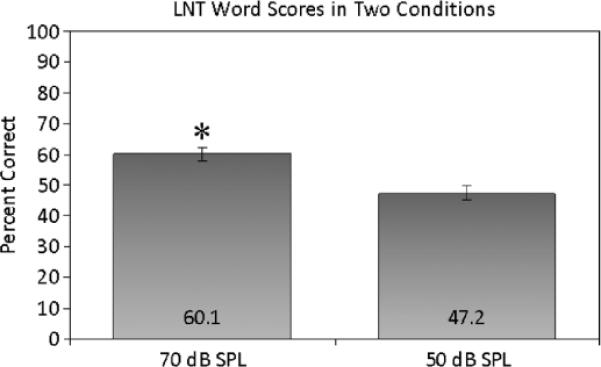
Mean percent correct LNT scores for the entire group of 112 participants at 70 dB SPL and 50 dB SPL. Error bars represent ±1 standard error of the mean.
FIG. 4.
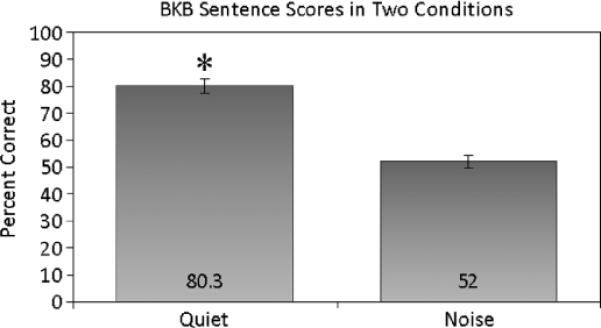
Mean percent correct BKB scores for the entire group of 112 participants in quiet and in noise (10 dB SNR). Error bars represent ±1 standard error of the mean.
The LNT scores at 70 versus 50 dB SPL and the BKB sentences scores in quiet and noise are shown in Figure 5 for the Freedom/3G and the Spectra/ESPrit 22 groups. Results from the repeated-measures ANOVA revealed that the LNT scores at 50 dB SPL were significantly higher for the Freedom/3G group compared with the Spectra/ESPrit 22 group (53.3% versus 33%) (F1,107 = 15.25, p < 0.0002). There were no significant differences between the bilateral CI users and the unilateral CI users in the Freedom/3G group, and the device group differences remained significant at the p < 0.0001 level when the bilateral CI users were excluded from the analysis. No significant differences between any groups were found for the LNT at 70 dB SPL, the BKB sentences in quiet, or the BKB in noise.
FIG. 5.
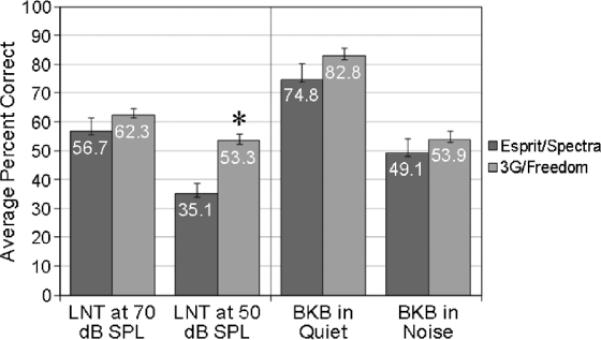
Mean LNT percent correct scores (n = 109) at 70 and 50 dB SPL and BKB scores in quiet and 10 dB SNR for the Freedom/3G and the Spectra/ESPrit 22 groups. Error bars represent ±1 standard error of the mean.
DISCUSSION
These results revealed that soft speech presented a challenge; however, children using updated processors that allowed for aided detection thresholds of 30 dB HL or better performed the best. Specifically, mean aided sound field thresholds at 250 to 4,000 HZ ranged from 27 to 30 dB HL with the Freedom and 3G processors, whereas thresholds for the children using the Spectra and ESPrit 22 processors ranged from 35 to 37 dB HL. As shown in Figure 2, aided thresholds of 30 dB HL or better offer greater audibility for soft speech levels as shown by the higher calculated AI for the Freedom/3G group compared with the Spectra/ESPrit 22 group (AI of 74 versus 45).
This increased audibility is evident by comparing the group mean LNT scores at 50 dB for the 2 groups in Figure 5. The mean score for the Freedom/3G group was 18% higher than the Spectra/ESPrit 22 group (53.3 versus 35.1). The improved aided thresholds and higher LNT scores at 50 dB for the Freedom/3G group seem to be related to device technology and not bilateral device use, as evidenced by no significant change in results when the 8 bilateral CI users were excluded from the analyses, and the lack of significant differences between the unilateral and bilateral Freedom/3G users. As expected, there were no significant differences between the groups for the LNT and BKB sentences at 70 dB as thresholds in the 35 to 37 dB HL would still allow for good detection of higher level speech inputs. The sentence scores in noise for the 2 groups are not significantly different and suggest that speech processors that offer greater access to low-level inputs allow greater access to soft speech without compromising listening in noise.
Acknowledgments
This research was supported by Grant RO1 DC0008335 from the National Institute on Deafness and Other Communication Disorders. Preparation for portions of this article was supported by Grant K23 DC008294. This research was approved by the Human Studies Committee at University of Texas, Dallas, TX.
REFERENCES
- 1.Skinner M, Clark G, Whitford L, et al. Evaluation of a new spectral peak coding strategy for the Nucleus 22 Channel Cochlear Implant System. Am J Otol. 1994;15:15–27. [PubMed] [Google Scholar]
- 2.Wilson B. Strategies for representing speech information with cochlear implants. In: Niparko J, Meller NK, Robbins A, Tucci D, Wilson B, editors. Cochlear Implants: Principals and Practices. Lippencott, Williams & Wilkins; Philadelphia, PA: 2000. pp. 129–70. [Google Scholar]
- 3.Geers A, Brenner C, Davidson L. Factors associated with development of speech perception skills in children implanted by age five. Ear Hear. 2003;24:24S–35. doi: 10.1097/01.AUD.0000051687.99218.0F. [DOI] [PubMed] [Google Scholar]
- 4.Geers A, Brenner C, Davidson L. Speech perception changes in children switching from M-Peak to SPEAK coding strategy. In: Waltzman S, Cohen N, editors. Cochlear Implants. Thieme Publications; New York, NY: 1999. p. 211. [Google Scholar]
- 5.Bess F, Dodd-Murphy J, Parker R. Children with minimal sensorineural hearing loss: Prevalence, educational performance, and functional status. Ear Hear. 1998;19:339–54. doi: 10.1097/00003446-199810000-00001. [DOI] [PubMed] [Google Scholar]
- 6.Flexer C. Facilitating Hearing and Listening in Young Children. 2nd ed. Singular; San Diego, CA: 1999. The importance of hearing and the impact of hearing problems; pp. 1–22. [Google Scholar]
- 7.Skinner M, Holden L, Holden TA, et al. Performance of post-lingually deaf adults with the Wearable Speech Processor (WSP III) and Mini Speech Processor (MSP) of the Nucleus multi-electrode cochlear implant. Ear Hear. 1991;12:3–22. doi: 10.1097/00003446-199102000-00002. [DOI] [PubMed] [Google Scholar]
- 8.Skinner M, Fourakis MS, Holden TA, Holden L, Demorest ME. Identification of speech by cochlear implant recipients with the Multipeak (MPEAK) and Spectral Peak (SPEAK) speech coding strategies II. Consonants. Ear Hear. 1999;20:443–60. doi: 10.1097/00003446-199912000-00001. [DOI] [PubMed] [Google Scholar]
- 9.Holden L, Vandali AE, Skinner M, Fourakis MS, Holden TA. Speech recognition with the Advanced Combination Encoder and the Transient Emphasis Spectral Maxima strategies in Nucleus 24 recipients. J Speech Hear Res. 2005;48:681–701. doi: 10.1044/1092-4388(2005/047). [DOI] [PubMed] [Google Scholar]
- 10.Firszt JB, Holden L, Skinner M, et al. Recognition of speech presented at soft to loud levels by adult cochlear implant recipients of three cochlear implant systems. Ear Hear. 2004;25:375–87. doi: 10.1097/01.aud.0000134552.22205.ee. [DOI] [PubMed] [Google Scholar]
- 11.Holden L, Skinner M, Fourakis MS. Effect of increased IIDR in the Nucleus Freedom cochlear implant system. J Am Acad Audiol. 2007;18:777–93. doi: 10.3766/jaaa.18.9.6. [DOI] [PubMed] [Google Scholar]
- 12.James CJ, Blamey P, Martin LF. Adaptive dynamic range optimization for cochlear implants: a preliminary study. Ear Hear. 2002;23:49S–58. doi: 10.1097/00003446-200202001-00006. [DOI] [PubMed] [Google Scholar]
- 13.Skinner M, Holden L, Holden TA, Demorest ME, Fourakis MS. Speech recognition at simulated soft, conversational, and raised-to-loud vocal efforts by adults with implants. J Acoust Soc Am. 1997;101:3766–82. doi: 10.1121/1.418383. [DOI] [PubMed] [Google Scholar]
- 14.McDermott HJ, Henshall KR, McCay CM. Benefits of syllabic input compression for users of cochlear implants. J Am Acad Audiol. 2002;13:14–24. [PubMed] [Google Scholar]
- 15.Dawson P, Decker JA, Psarros C. Optimizing dynamic range in children using the nucleus cochlear implant. Ear Hear. 2004;25:230–41. doi: 10.1097/01.aud.0000130795.66185.28. [DOI] [PubMed] [Google Scholar]
- 16.Cosendai G, Pelizzone M. Effects of acoustical dynamic range on speech recognition with cochlear implants. Audiology. 2001;40:272–81. doi: 10.3109/00206090109073121. [DOI] [PubMed] [Google Scholar]
- 17.Zeng FG, Grant G, Niparko J. Speech dynamic range and its effect of cochlear implant performance. J Acoust Soc Am. 2002;11:377–86. doi: 10.1121/1.1423926. [DOI] [PubMed] [Google Scholar]
- 18.Dawson P, Vandali AE, Knight MR. Clinical evaluation of expanded input dynamic range in nucleus cochlear implants. Ear Hear. 2007;28:163–76. doi: 10.1097/AUD.0b013e3180312651. [DOI] [PubMed] [Google Scholar]
- 19.Davidson L, Skinner M, Holstad B, et al. The effect of instantaneous input dynamic range on the speech perception of children with the nucleus 24 implant. Ear Hear. 2009;30:340–9. doi: 10.1097/AUD.0b013e31819ec93a. [DOI] [PMC free article] [PubMed] [Google Scholar]
- 20.Kirk K, Pisoni D, Osberger M. Lexical effects of spoken word recognition by pediatric cochlear implant users. Ear Hear. 1995;16:225–59. doi: 10.1097/00003446-199510000-00004. [DOI] [PMC free article] [PubMed] [Google Scholar]
- 21.Bamford J, Wilson I. Methodological considerations and practical aspects of the BKB sentence lists. In: Bench J, Bamford J, editors. Speech-Hearing Tests and the Spoken Language of Hearing Impaired Children. Academic Press; London, UK: 1979. [Google Scholar]


